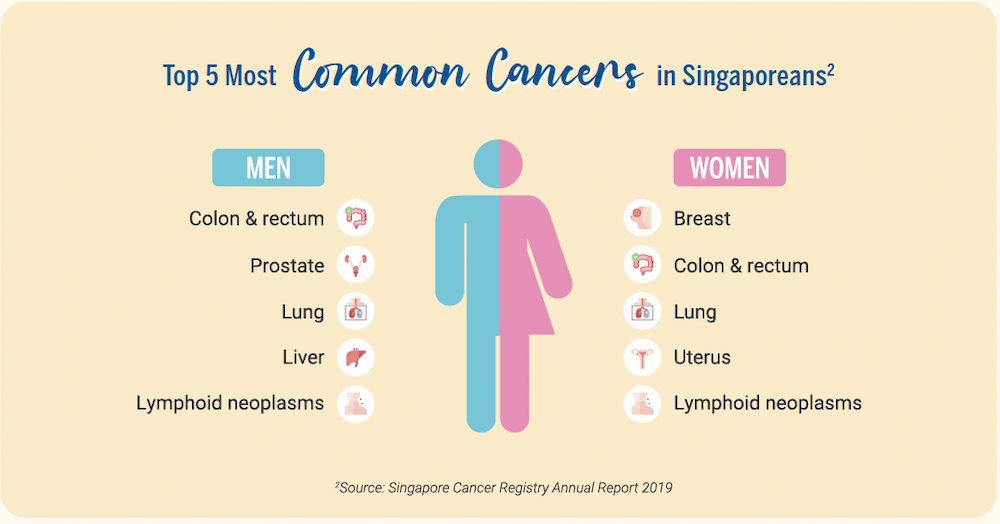News & Articles

Cancer Statistics, Screening and Treatment in 2023

Dr Wong Siew Wei, Senior Consultant, Medical Oncology explains the latest cancer statistics, screening and treatment in 2023.
The incidence of cancer in Singapore has risen for both males and females over the last 50 years.
Today, cancer is the top cause of death in Singapore, accounting for almost 1 in 3 deaths in the total population1.
This trend is largely attributed to urban lifestyle factors such as smoking, excessive alcohol intake, increased stress levels and higher rates of obesity, which increase an individual’s risk of developing chronic diseases such as cancer.

| Top 5 Most Common Cancers in Singaporeans2 | ||
| Men | Women | |
| ||
Advances in screening, imaging and treatment
While incidence rates for cancer are at an all-time high, with over 78,000 new cases diagnosed over a five-year period of 2015–2019, survival rates have improved for many cancers thanks to advances in cancer screening, imaging and treatment.
Cancer screening in particular helps individuals without symptoms to detect cancer or precancerous conditions at an early stage, allowing for timely intervention and treatment.
This makes it a powerful tool in the fight against cancer, as cancer treatment is most effective when the disease is discovered in its early stages. An estimated 40% of cancers are preventable with cancer screening.
Improved diagnostic tests—which include cancer imaging and molecular profiling of cancers—allow for an accurate assessment of each individual cancer case. Armed with better understanding of the stage and molecular subclass of cancers, doctors can prescribe patients the most appropriate, effective and least invasive treatment to optimise patient outcomes.
Cancer treatment options in 2023
Over the last decade, cancer treatment options have extended to a wide arsenal of treatment modalities and techniques, from surgery to chemotherapy, radiation therapy, radionuclide therapy, targeted therapy, immunotherapy, antibody-drug conjugates and hormonal therapy.
Conventional treatment such as surgery, chemotherapy and radiation therapy remain the standard of treatment for many cancers, but have evolved to become more precise and better tolerated.
Newer surgical techniques such as minimally invasive surgery and robotic surgery, for instance, are more superior, offering patients faster recovery times and lower complication rates.
Radiation therapy has also modernised with new developments such as intensity-modulated radiation therapy (IMRT) and proton beam therapy, which allow doctors to target tumours better while reducing exposure to adjacent critical organs. Optimal radiation dose can be delivered with minimal side effects.
New cancer drugs
The emergence of new cancer drugs is transforming the treatment landscape and cancer outcomes.
The identification of driver mutations thanks to improved molecular profiling of cancer, for example, allow patients to be matched to the most effective targeted therapies, often with minimal side effects compared to traditional chemotherapy. The best example is the treatment of advanced lung cancers, which had no targeted therapy option two decades ago. Currently, up to 60% of advanced lung cancer patients can benefit from targeted therapy.
Immunotherapy has also rapidly become the cornerstone of treatment for many cancers over the years, not just in the advanced stage setting, but in the early stage setting as well. One good example is immunotherapy that targets checkpoint proteins called ‘checkpoint inhibitors’. Cancer cells may evade immune system detection and destruction by ‘switching off’ the immune response. Checkpoint inhibitors help ‘switch on’ and restore the immune system to detect and destroy these cancer cells.
Antibody-drug conjugate is a new class of drugs, where monoclonal antibodies against proteins expressed on cancer cells surface (cancer antigens), are linked with very potent chemotherapy. The potent chemotherapy payload is only released into cancer cells and surrounding areas, when the ‘homing’ antibodies have attached to cancer antigens.
Thanks to these new treatment advances, cancer cure rates have improved significantly. Even cancers that are challenging to treat previously can now be managed with potentially a long period of disease control.
Moving from a ‘one size fits all’ approach
The incidence of cancer may have risen, but survival rates for many cancers have improved with early detection, more accurate diagnostic tests, and more advanced and better tolerated treatment modalities.
With so many treatment advances across different disciplines, each patient can benefit from a personalised, multidisciplinary treatment plan based on their general health and accurate assessment of their cancer, as opposed to a ‘one size fits all’ approach.
Individuals can also take charge of their own health by making positive lifestyle changes to reduce their risk of cancer and other serious diseases. Some steps individuals can take include adopting a healthy lifestyle (e.g. avoid smoking, maintaining a healthy weight, exercising regularly, eating a balanced diet, minimising alcohol consumption), undergoing vaccination to reduce the risk of virus-mediated cancer such as Human Papillomavirus (HPV) and Hepatitis B, and undergoing appropriate cancer screening.
| POSTED IN | Cancer Prevention, Cancer Treatments |
| TAGS | cancer mutation, cancer screening, cancer survivorship, chemotherapy, immunotherapy, prevent cancer, radiotherapy (radiation therapy), robotic surgery, targeted therapy |
| READ MORE ABOUT | Breast Cancer, Colorectal Cancer, Liver Cancer, Lung Cancer, Prostate Cancer |
| PUBLISHED | 01 January 2023 |
